- Cross, N., Driver, S., Lemon, D., 2001, in Proc 'New Era of Wide-Field Astronomy', eds R. G. Clowes, A. J. Adamson, G. E. Brommage, ASP Conference Series (in press) (astro-ph/0010418). Citation in text | LANL
- Everett, M. E., et al., 2001, MNRAS (submitted) (astro-ph/0009479). Citation in text | LANL
- Greimel, R., Lewis, J. R., Walton, N. A., 2001, ING Newsl, 4 (this issue). Citation in text
- Groot, P. J., et al., 2001, MNRAS (submitted) (astro-ph/0009478). Citation in text | LANL
- McMahon, R. G., Walton, N. A., Irwin, M. J., Lewis, J. R., Bunclark, P. S., Jones, D. H., 2001, NewAR, 45, 97. Citation in article | ADS
- Perlmutter, S., et al., 1999, ApJ, 517, 565. Citation in article | ADS
- Riess A. G., et al., 1998, AJ, 116, 1009. Citation in article | ADS
- Rutten, R. G. M., 2001, ING Newsl, 4 (this issue). Citation in text
- Sharp, R. S., Hodgkin, S. T., McMahon, R. G., Irwin, M. J., 2001, ING Newsl, 4 (this issue). Citation in text
- Steidel, C. C., Giavalisco, M., Dickinson, M., Adelberger, K. L., 1996, ApJ, 462, L17. Citation in article | ADS
- Trentham, N., Moeller, O, Ramírez-Ruiz, E., 2001, MNRAS (submitted) (astro-ph/0010545). Citation in text | LANL
- Walton, N. A., Irwin, M. J., McMahon, R. G., Lewis, J. R., 1999, ING Newsl, 1, 3. Citation in text
- Walton, N. A., Lennon, D. J., Greimel, R., Irwin, M. J., Lewis, J. R., Rixon, G. T., 2001, ING Newsl, 4 (this issue). Citation in text
| THE ING NEWSLETTER | No. 4, March 2001 |
|
|
THE ING WIDE FIELD IMAGING SURVEY | SCIENCE |
|
|
|
| Previous: | Contacts at ING | Up: | Table of Contents | Next: | The Wide Field Camera and Infrastructure |
Other available formats: PDF | gzipped Postscript
|
Science Highlights
from the ING Wide Field Survey
Nicholas A. Walton, Daniel J. Lennon (ING) and Mike J. Irwin, Richard G. McMahon (IoA) |
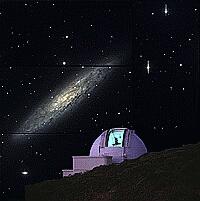
THE ING WIDE FIELD IMAGING SURVEY |
The Isaac Newton Group's public access Wide Field Survey (WFS) makes use of the Wide Field Camera on the Isaac Newton Telescope to carry out a range of competitively judged survey programmes. Multicolour data, immediately accessible to the UK and NL communities, over 200+ square degrees to a typical depth of 24 mag (from Sloan-Gunn u' through z' filters) is being obtained.
The WFS archive now contains some 0.7 TB of reduced and calibrated image data on-line. This equates to some 2000 square degrees of sky coverage and currently represents the world's largest reduced CCD sky survey available on-line.
This article gives a brief overview of the WFS's first five semesters of operation, describing some science highlights. This issue of the ING Newsletter also contains associated articles describing the second round of programmes of the WFS (René Rutten, this issue) and a more detailed look at the data reduction pipeline employed to handle WFS data (Robert Greimel et al., this issue). Attention is also paid to the development of the Wide Field Camera and its associated data acquisition system in the article by Walton et al. (this issue).
Full details and access to the survey are available at the ING WFS portal at: http://www.ing.iac.es/Astronomy/science/wfs/ or the CASU page at: http://www.ast.cam.ac.uk/~wfcsur.
1 The First Wide Field Survey Programmes
The competitively judged 1st period
(Aug 1999 – Jan 2001) WFS science programmes encompassed a wide range of
topics: from growth of structure and clusters of galaxies to stellar populations
to outer solar system studies. The data is immediately publically accessible
to the UK and NL communities and after a year to the rest of the world.
The location of the fields surveyed (till November 2000) are shown graphically
in Figure 1.
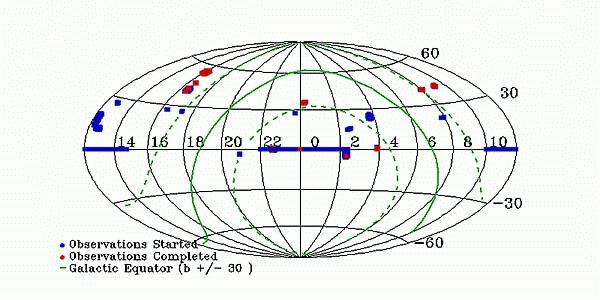 |
|
|
2 The Wide Field Survey Science
In the following, some preliminary science results resulting from WFS programmes are outlined. In addition, Sharp et al. (2001, this issue) discuss the discovery of High-Redshift Quasars with WFS data.
2.1 Wide Angle Survey (WAS) Highlights
This main WFS programme (PI: Richard McMahon) brought together a diverse range of scientific topics, merging the observational programme to increase scientific effectiveness. A representative selection of core programmes is highlighted. An overview of the main programmes being addressed in the WAS can be found in Walton et al. (1999), McMahon et al. (2001) and at http://www.ast.cam.ac.uk/~rgm/int_sur/
2.1.1 Brown Dwarfs in The Pleiades
WFS survey data for ~2.7 deg2 has been obtained in the Pleiades. Ninety brown dwarf candidates were identified from the i', i'–Z diagram. IR photometry of this sample confirmed twenty five as brown dwarfs. The faintest, at I=22.5 and with a colour of I–K=5.6, possibly makes this the lowest mass brown dwarf yet found in the Pleiades. In order to understand the low-mass end of the cluster mass function, masses below 35MJup must be probed. Further observations are extending the 'Pleiades survey' out to the semi-tidal radius to determine the spatial distribution of brown dwarfs in the cluster and to assess the form of the mass function.
2.1.2 Intermediate Type Ia Supernovae
Major progress in the determination of the fundamental cosmological parameters (Omega, Lambda) has been made using Type Ia supernovae (SN) at 0.4<z<1 (see e.g. Perlmutter et al., 1999, Riess et al., 1998). However, these results are limited by systematic errors in the properties of low redshift SN. The WAS survey identified ~20 new Type Ia SN in the critical range 0.1<z<0.4, analysis of which is allowing a detailed treatment of these systematic errors.
2.1.3 New Low Surface Brightness (LSB) Galaxies in Virgo
As part of the Virgo survey component, led by Jon Davies (Cardiff), some 25 square degrees of Virgo were obtained in the B photometric band, and the pipeline processed object catalogues were analysed. More than 500 LSB galaxies with Btot<21 were discovered by comparing the light profiles of the millions of objects in the data frames with those of previously known template LSB galaxies. Figure 2 shows an example LSB dwarf galaxy. The luminosity function in Virgo, when combined with the much flatter function found in the field, will enable the efficiency of low mass galaxy formation in differing environments to be investigated. First results are indicating a strong environmental dependence, which would need to be taken into consideration by Cold Dark Matter theories.
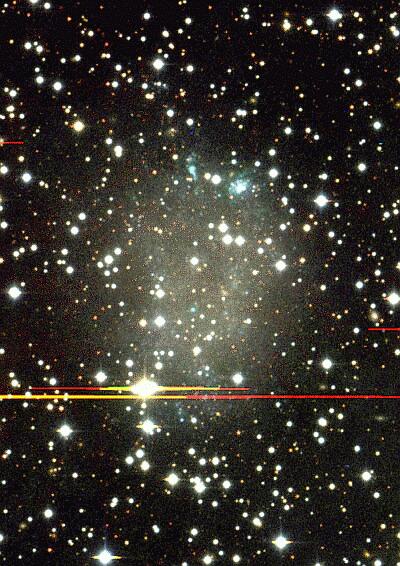 |
| Figure 2. An example of a low surface brightness dwarf galaxy, this one in Cepheus, recently discovered by Whiting, Hau and Irwin. The image is a colour composite picture created from 1200 second exposures in g', r' and i'-band images taken in sub-arcsec conditions. [ JPEG | TIFF ] |
2.1.4 The Millennium Galaxy Catalogue (MGC)
The MGC, being completed by Simon Driver (St. Andrews), aims to define a complete galaxy catalogue of the local environment covering a homogeneous volume (V~100h–3Mpc3) for all galaxy types independent of surface brightness selection. The MGC survey strip encompasses 2dF galaxy red-shift survey fields, thus some ~4000 spectroscopic red-shifts exist for galaxies in this region (Cross et al., 2001). Data for the strip of 0.5 degrees by 70 degrees has now been obtained. Further details can be found at the MGC home page (http://star-www.st-and.ac.uk/~spd3/mgc/mgc.html)
2.2 The Oxford Deep WFC Survey
This represents the 'deep' component of the WFS (PI: Gavin Dalton). Its primary goal is to investigate the angular clustering properties of galaxies as a function of colour to a red-shift of z~1. Current analysis has allowed a measure of angular clustering to ~0.2 degree scales for 25<R<25.5.
Extremely Red Objects (R–K>6) are being found by comparing the WFS data with K band data from the MDM 1.3-m telescope. Preliminary analysis indicates that there are distinct ERO populations representing post-starburst galaxies and old cluster ellipticals at z>1.
The Oxford data are also being used to search for Lyman break galaxies at z=3 and z=4. In particular, the correlation length of these galaxies is being found as the Oxford data set covers larger areas to similar depths to that used in previous Lyman break galaxy search campaigns (e.g. Steidel et al., 1996). Further details of the Oxford Deep Survey can be found at http://www-astro.physics.ox.ac.uk/~gbd/WFC/.
2.3 Faint Sky Variability Survey (FSVS)
This survey (PI: Ed van den Heuvel) forms the 'variability' component of the WFS, obtaining deep wide field BVI photometric data towards high and moderate galactic magnitudes (Groot et al., 2001). Photometric accuracies of up to 3 millimag (for V=17 mag objects) have been obtained. Over 100,000 point sources have had light curves constructed. The main scientific targets include CVs, RR Lyrae stars, optical transients of GRB's, Kuiper Belt objects and so forth. Variability and colour selected samples are being spectroscopically followed up with 4-m and 10-m class telescopes. Full details and access to the processed data sets for this project can be found at http://zon.wins.uva.nl/~fsvs/.
2.4 Dark Galaxies
Trentham
and co-workers (2001)
have suggested that galaxies with significant mass could exist with no
stars, made up entirely of dark matter. This theory extrapolates from the
currently well known observation that bright galaxies contain significant
amounts of dark matter, with mass to light rations of 10 to 1 not being
uncommon. One example of such a dark galaxy has been identified from WFS
images —the galaxy UGC 10214 (see Figure 3) has
a stream of material flowing out of it, typical of those seen in interacting
galaxy pairs (see Figure 4). However, there is no
other galaxy or source of visible light present, the companion interacting
object is therefore dark.
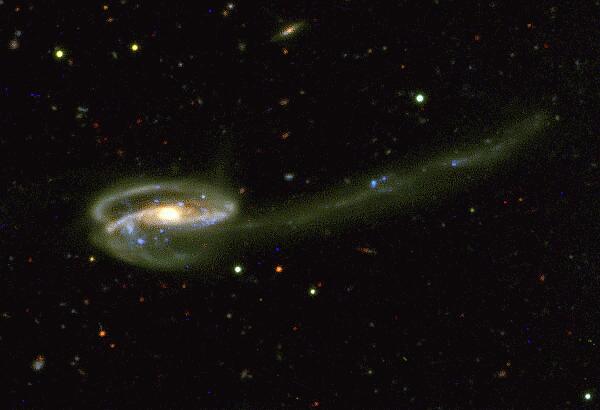 |
| Figure 3. The false colour image (u', g', i' filters) of galaxy UGC 10214, thanks to Simon Hodgkin at Cambridge Astronomical Survey Unit (CASU). [ JPEG | TIFF ] |
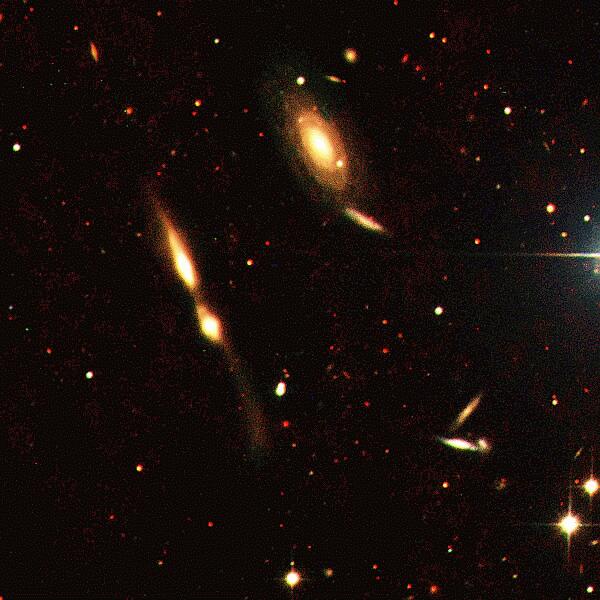 |
| Figure 4. A pair of interacting galaxies —taken from the FSVS— see http://zon.wins.uva.nl/~fsvs/html/images.html. [ JPEG | TIFF ] |
3 The Next Years: New Programmes
The strength of the WFS concept was confirmed with support for the continuation of the programme for a further three year period. The programmes supported, a blend of continuing 1st round programmes supplemented with new programmes, are discussed elsewhere (René Rutten, this issue).
The WFS optical data will be supplemented from Spring 2001 with near-IR J and H band data. This will be obtained with the IoA's CIRSI IR camera (see http://www.ast.cam.ac.uk/~optics/cirsi/) operating on the INT.
4 Data Products and Usage
Some 35000 4×2k science frames had been accumulated through the WFS in the period August 1998 till November 2000. This equates to some 0.7 TB of processed science data with derived catalogues amounting to an additional of 20 GB. The science data volume corresponds to some 2000 square degrees of sky.
The WWW pages to the WFS at both CASU and the ING are being or have been redesigned to improve the interface to the WFS data products. The calibration and characterisation data is of use in the reduction of all WFC data.
Improvements have been made to the astrometric solutions, these now being better than 100mas (internal) across the CCDs. The photometric calibration of the survey is progressing with the development of automatic extraction of standard Landolt calibration field observations, and the subsequent photometric solutions being applied to the object catalogue data.
5 Closing Remarks
The WFS is now running routinely. Significant data sets now exist and are available to the community. A wide range of scientific analyses is currently underway, with many exciting new results on the horizon. The WFS data, in conjunction with possible complementary near-IR data from the UKIRT WFCAM, will provide an important resource to the UK/NL communities.
The operation of the survey, and implementation of the supporting infrastructure (observing systems, processing systems, data dissemination) is providing vital experience to the UK in advance of more major survey activities planned with the next generation survey facilities such as the VISTA telescope.
References:
Email contact: Nic Walton (naw@ing.iac.es)
| Previous: | Contacts at ING | Up: | Table of Contents | Next: | The Wide Field Camera and Infrastructure |
| GENERAL | THE ING WIDE FIELD IMAGING SURVEY | SCIENCE | TELESCOPES AND INSTRUMENTATION | OTHER NEWS FROM ING | TELESCOPE TIME |